Under a carved stone down an ancient quiet lane in deepest darkest Lancashire, supposably lies a trapped boggart, a relic of olde times, the said boggart maybe still alive and plotting for when it escapes into a much changed world.
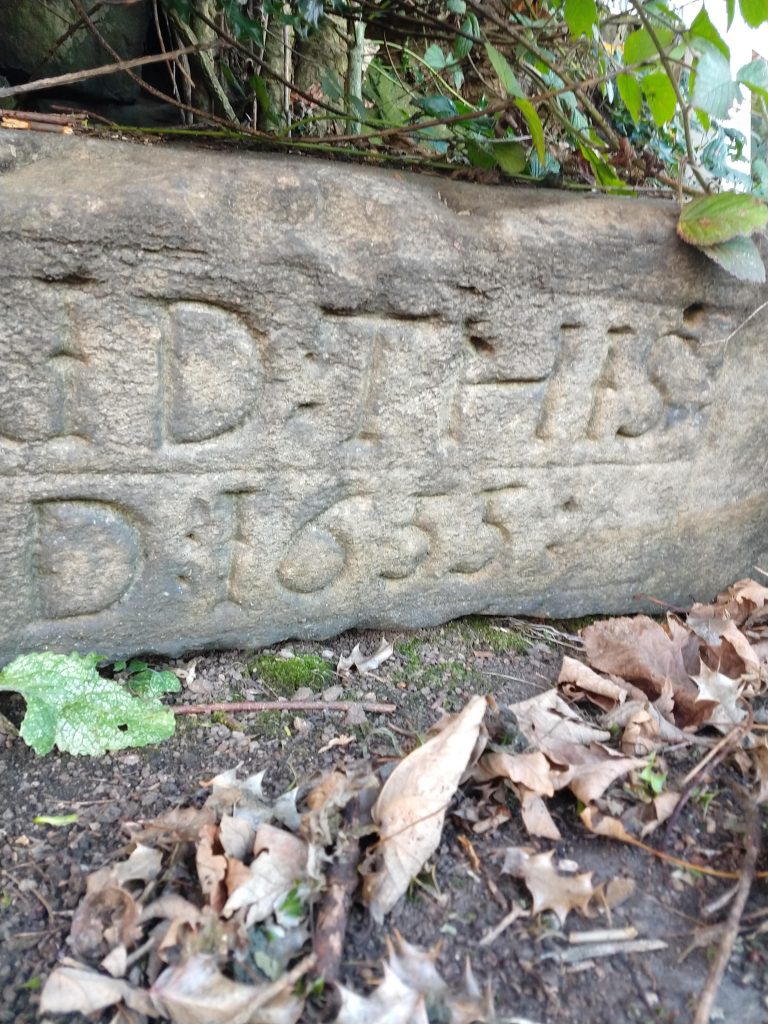
When it was entombed or tricked into its residing place, Oliver Cromwell’s soldiers had been recently marching through the near vicinity. Now its resting place is the same but the carriages are a lot faster and the prices at the nearby inn a lot dearer.
A Boggart is a household spirit or a malevolent genius loci inhabiting fields, marshes or other topographical features.
Boggarts, like scold’s bridles, Alcatel phones and leech bleeding slipped gently into a superstitious uncivilised past, forgotten and ignored until they suddenly and surprisingly became big on the internet due to their appearance in the Harry Potter books and films.
I was quite sad to discover the fact that Boggarts were A Thing when researching them online. I presumed they were all mine. A brief Google and a strangle Boggart related jealousy. It’s like when you and only you liked that band and then they became popular.
Anyway. Boggarts. Cruel mischievous sprites from long ago residing in the edgelands, marshes, bogs, the far away. Remnants from the past, the ‘old race,’ the Celtic tribes, the pagans. The dark side of fairy lore.
In folklore, often the same legendary creatures crop up like mushrooms in isolated spots, not to be seen in other parts of the country. The Boggart is a mostly North West residing beast and this may be due to the links between the old Westmoreland borders and the neighbouring Celtic Welsh regions where a similar archaic Gaelic language was spoken- think small secretive darker hued people with ferocious reputations hidden away in darkened areas, feared by some and speaking a different tongue or dialect. See any similarities?
‘Stars is shining, moon is breet,
Boggart won’t be coming out toneet’- old Lancashire children’s chant
Written Stone Lane
Along an ancient Roman lane , helpfully named Written Stone Lane for those seeking a written stone, lies a written stone. The stone is easy to find, not just for its useful address but for its size. It lies near the entrance to Cottam House Farm, the old name of Cottam has already been mentioned in this book.
For those who really really struggle, the area is apparently locally known as Boggarts Lane, just in case the whole Written Stone thing is not enough.
In the spirit of enquiry I type ‘Boggarts Lane Longridge’ into Google Maps but the closest thing of interest is the Shay Lane Industrial estate. I do despair of modern times.
Those looking for the arcane, esoteric and ancient often stumble when looking for the past; pitiful memorials overshadowed or lost forever by time, industry and agriculture become just another rough boulder, no-one left to tell of its past as a lurid piece of history and folklore, a place of suspended disbelief, thrilled rumours and dark secrets. Thus it lies forgotten and ignored,somewhere near an industrial estate or a suspicious farmer; history that nobody can decipher or ever read again.
The holly that surrounds the stone is part of its past, a sacred plant revered by the druids and known to thwart witchcraft, bringing it into your house during the Christmas period, a custom to protect those revelling inside from forces of darkness. The fact so much holly grows here has been mentioned with much reverence and superstition in old writing relating to the stone. Some say it was planted here to keep the boggart at rest and as long as holly remains here, so does the boggart. Old old superstitions around an old old stone, planted down a small road somewhere near Preston.
The Written Stone is nine feet long, two feet wide and a foot thick and the deeply engraved writing, hewn (passionately?) deeply into the stone rather than the more common of the time raised letters, shows it to be a stone with a tale to tell. A story from the past, the words laboriously carved so deeply as to not be interred by moss and dirt. The person who laboured over this stone wanted it to be remembered, wanted the story to never be forgotten. The stone reads
‘Ravffe Radcliffe Laid This Stone to Lye For Ever A.D. 1655’
The Radcliffes and the legend
So many stories, so many translations as you try and sift through the past.
Some tales speak of ‘a cruel and barbarous murder’ being committed here in this quiet godforsaken spot and for some strange reason, the victim being buried here instead of in consecrated land. The legend is given a certain credulity when noting the amount of the Radcliffe family that suffered an impromptu demise very close to the dates carved so deeply into the stone’s surface. But why would a member of such a worthy god-fearing family be buried here instead of a consecrated graveyard?
Other sources say that the murdered soul underneath cries for justice and all malice is harboured towards the nearby Radcliffe family due to a member of them being the perpetrator of such dark deeds.
The unknown body under the stone did not lie quiet in the soft earth and but for such a quiet place allegedly made itself very known.
‘which played its nightly gambols long after the body had been hearsed in the earth,’
It is said in other sources that after the whatever it was had been placed under the stone, then the Radcliffe family started dying in uncommon quickness.
From A History of Longridge
‘From a careful perusal of the Parish
Registers at Ribchester, I find under the
heading of ” Longridge burials ” the fol-
lowing notices : —
Ralph Radcliffe, Died 26 Feb., 1C34.
Son of above Ralph, Died 4 Mar., 1654.
Wm. Radcliffe, Died 20 May, 1C65.
Wife of John Radcliffe, Died May,
1055 (illegible).
‘What is more likely than that this stone
was laid either to commemorate these
deaths following so close upon one an-
other, or that a feeling of superstitious
awe may have been awakened in the
breasts of the survivors of the bereaved
family, and caused them to lay the stone
in order to appease the evil spirit that
had caused so much trouble? Certainly
it i.s a curious coincidence, and not, I
think, an undesigned one.‘
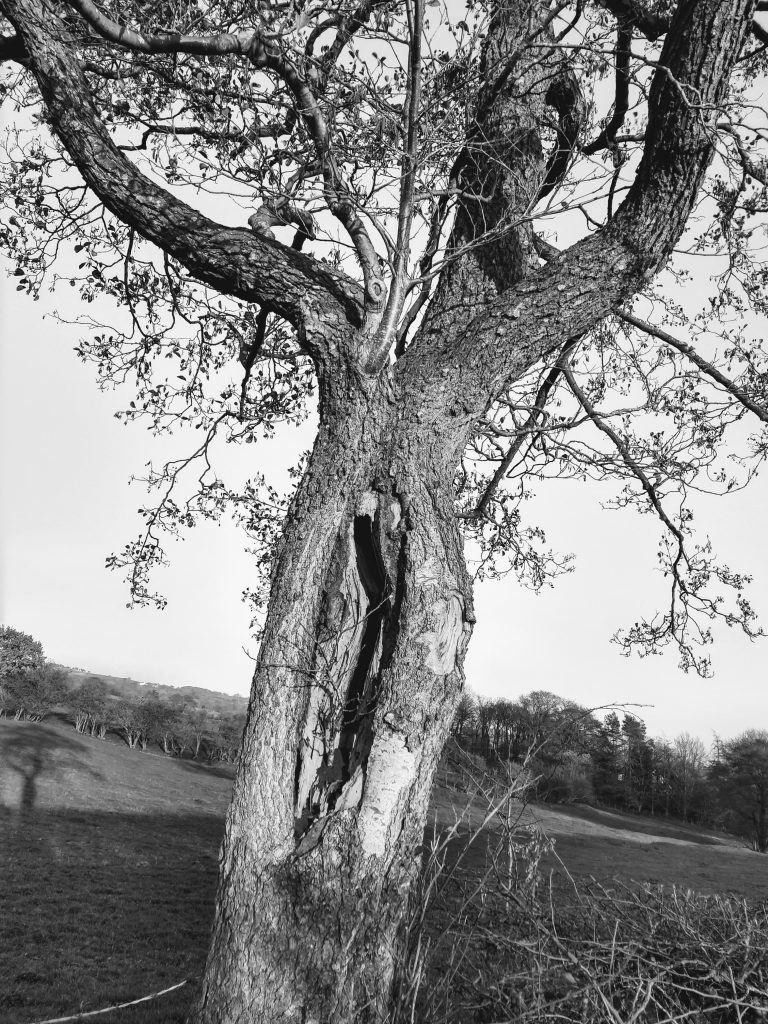
The malice was not just aimed directly at the Radcliffes, many travellers upon that lonely road complained of all manner of unpleasant devilish behaviour, clothes plucking, shrieks, loud bangs, pinching. I am reminded of when I used to work in a nursery.
This is a stone without a burial engraved upon it, yet a stone calligraphed by such an important local family, a stone without a tomb, a graveyard but in such significance of place, it needed to ‘lye there forever’. Yet the significance of the place, halfway down a small road leading nowhere.
So what happened here so many hundreds of years ago?
Stories vary as to a failed exorcism of the murdered soul, maybe causing a boggart to lurk in such a pleasingly devilish place to the boggart himself being entombed alive underneath the stone to stop any more devilish mayhem.
Boggarts were said to appeased with a saucer of milk, more associated with a friendly cat than a small hairy evil sprite bent on gleeful mayhem and death who could however be pacified with small acts of kindness and occasionally be helpful. Ok, there might be some similarities…
A quick Google search of ‘Radcliffe family, Cottam House,’ throws up some surprising modern images of particularly banal modern estate housing rather than the expected pen and ink drawing of a crumbling manor house.
The dating on the stone comes a few years after plague times when poverty and pestilence reigned supreme but at a time when witchcraft and superstition were at a peak.
From The History Of Longridge and District 1888
‘hath the plague of pestilence been
raging for these three years and upwards, occasioned chiefly by the
wars. There is very great scarcity and dearth of all provisions,
especially of all sorts of grain, which is fully six-fold the price that of
lata it hath been. All trade, by which they have been much
supported, is utterly decayed ; it would molt any good heart to see the
numerous swarms of begging poor, and the many families that pine
away at home, not having faces to beg.’’
Research draws a frustrating blank about the supposed murder and the strange circumstances of the close deaths of the Radcliffe family around the time of the stone being laid.
The Boggart
It is written in the book, ‘Lancashire Ghosts and Legends’ however, that the stone has for hundreds of years been a lonely prison for a boggart who was responsible for the aforesaid noises and despite being contained under the hefty slab was still responsible for frightening several people to death. Not bad going, really considering the lack of footfall and being entombed and all. Ralph Radcliffe it is said, as an act of revenge for so many of his family so suddenly dying, somehow managed to imprison the devilish sprite and popped the slab over to keep him from causing any more problems.
In ‘Lancashire Magic and Mystery’, the legend is that a murdered soul would not keep quiet in their unconsecrated lonely grave and sought justice by the somehow murderously implicated Radcliffe family and so Ralph ordered in a local priest to perform an exorcism by praying in the lane and the nearby Radcliffe household. It was then that the stone was laid. It appeared to have worked for a time but then the same phenomena started reoccurring again.
A writer for the Stonyhurst magazine, the inhouse magazine for the old renowned public school near Clitheroe mentions a female figure seen close to the stone, wraithlike and always tantalisingly close, always vanishing, always elusive but so so near.
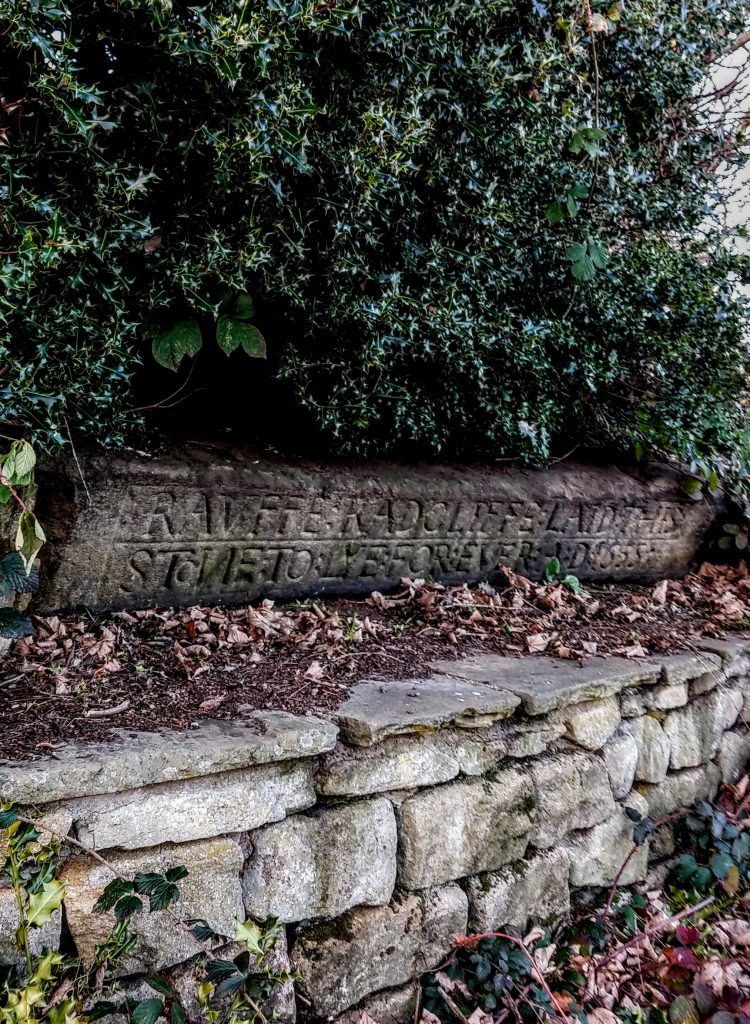
A local doctor on his rounds one dark night was said to have seen a cloudy miasma suddenly appearing before him and that fateful stone. Evolving and shifting, coming closer and closer, a dark matter with dark intent, it was inescapable, smothering with a light suffocating cloak of cloud, both himself and his horse. He said afterwards that he was lucky to escape with his life.
No mention of a boggart, just another Satanic creature of darkness residing here.
Another version has the plucky doctor, fortified with strong spirits from the local hostelry passing by this ill-fated spot when suddenly his placid beast became hysterical, bucking and plunging, racing frothy mouthed and wide eyes before finally coming to a trembling stop, covered in blood. This version has him bravely or foolishly returning a second time which is then he is enveloped by the ghostly wraith. ( Lancashire Legends, Kathleen Eyre)
Lancashire Magic and Mystery also has a theory that the stone itself is the malign entity. Such a flat slab, of such an unusual size and dimension, a stone as pleasingly flat and long would have been prized in even more ancient times as a pagan, Celtic maybe even sacrificial altar. How many uses has this stone had over the centuries?
The close reader will have noted that the sprightly boggart leaps lightly through this tale, one minute there, the next century to have hardly existed in the tale.
He comes to his own in the next chapter.
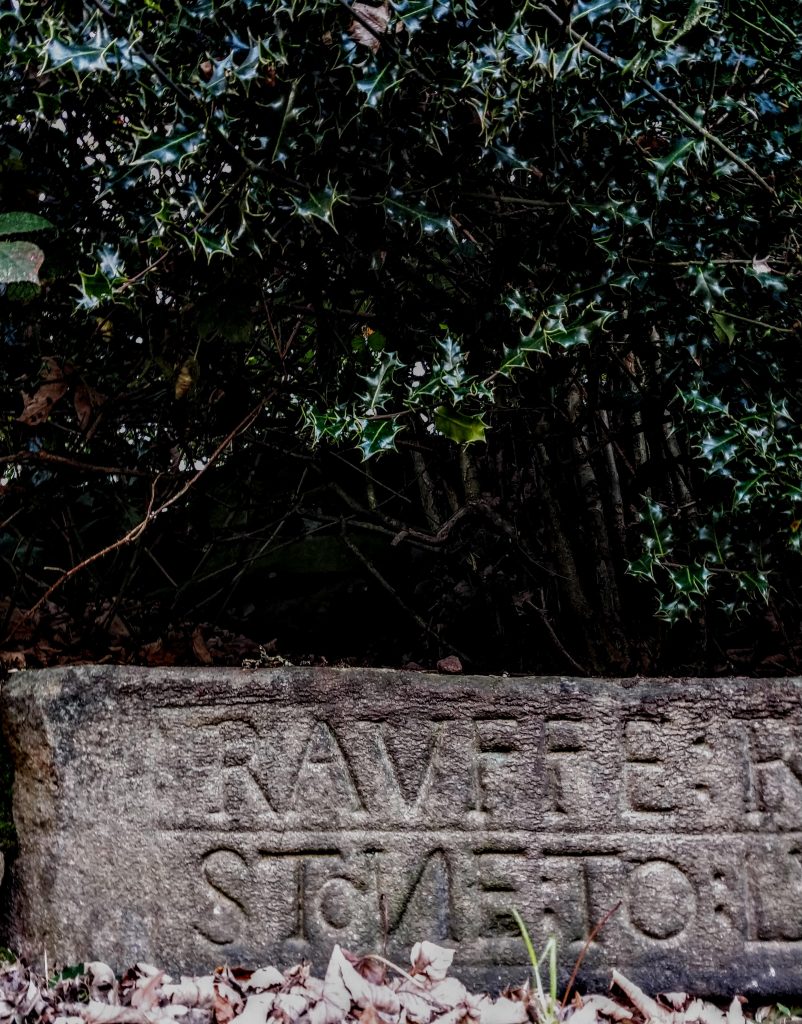
The escape of the Boggart?
There was never a golden age where everything stayed a happily homogeneous same: nobody plundered, nowhere was engaged in warfare with neighbouring tribes, far away tribes or their immediate bin stealing dog owning neighbours. Where everyone was fed well and drank well with steaming meaty pies and good ale, much good cheer and definitely no cheering and lolling at a good hanging or witch burning.
Even rich gentility were unsafe due to the swerving decisive allegiances between faiths powered by whoever happened to be on the throne and those who wanted to be on the throne or those who wanted their friends or family or acquaintances of the same religion to be on the throne to suit a multitude of agendas, mostly due to acquiring land, power and more money.
Rich people became poor, poor people became rich.
Thomas Cottam of the historically local family, tortured and then executed at Tyburn in 1582 for his priesthood.
History wasn’t sanctified, history happened to the dead, people did what they could to survive in a cold hostile climate. Stones were stones.
Years later, decades later and a nearby farm needs stones for its buttery. This stone might be ancient, might have been laid in perpetuity but stones are stones and butteries need to produce butter. People need to live. People are hungry, people need butter.
A stone lies nearby. It is a stone of significance, legends lie around the stone, are written on the stone, tales of murder, tales of boggarts surround the stone. Everyone knows of the stone.
But it is a good stone. A strong stone, a thick slab, it will work well, this stone again, surely all history is reused and what use is history is people need butter and a buttery needs to be made of strong thick stone?
Farmers are prosaic.
This farmer took six strong horses to pull the stone to his farm. An easy task, a short downhill trot and the job done.
It went wrong from the very beginning. The horses as if encumbered by some unknown other weight sagged, white eyed and trembling, each hoofprint tremulous, one hoof forward, three hooves back, the horizon slipping backwards, the written stone sliding and tipping. Local landmarks near but never closer. Hooves slipping, stone sliding, the same distance an hour later, the boulder, heavier, heavier, heavier. Hooves more entrenched in deeper mud, terrified eyes more rolled, a journey begun but a mile from home, a loaden more strangely heavy. But still somehow so far away.
It took a long long time for the stone to reach the farm. The once proud strong horses steaming and screaming on a journey so short.
Finally the stone reached the buttery. The horses were broken, their containment of stone finally removed.
It may not surprise the reader to hear that things did not improve once the haunted stone was laid as part of the buttery.
The old Written Stone tilts invisibly to slide and thus smashes anything placed upon it ( a slight suspicion possibly lies on butter fingered staff who accidentally smash household objects near a happily silent cursed cursed stone that is well known for being rather obtuse)
Old farmhouse pottery, passed down through families is found broken, the farmer responsible for the movement of the stone abed, wide-eyed and trembling. He has heard the sound of the smashing of generations, know there is true spite lying below.
“Whatever pots, pans, kettles or article of crockery were placed on the stone, were titled over, their contents spilled and the vessels themselves kept up a clattering dance the live-long night at the beck of the unseen spirit.’’
Staff, family or the undead? When you are lying in your bed, lit only by the moon, waiting for the door to open or for dawn to finally arise, which entity is worse? That time between nightfall and daylight is a long time, the time you regret, you promise, you vow, you are dry lipped and terrified, remorseful and penitent.
A short time passed, tales of ‘milk turned to blood when out upon the written stone’, a maid servant ‘witched and died soon after.’
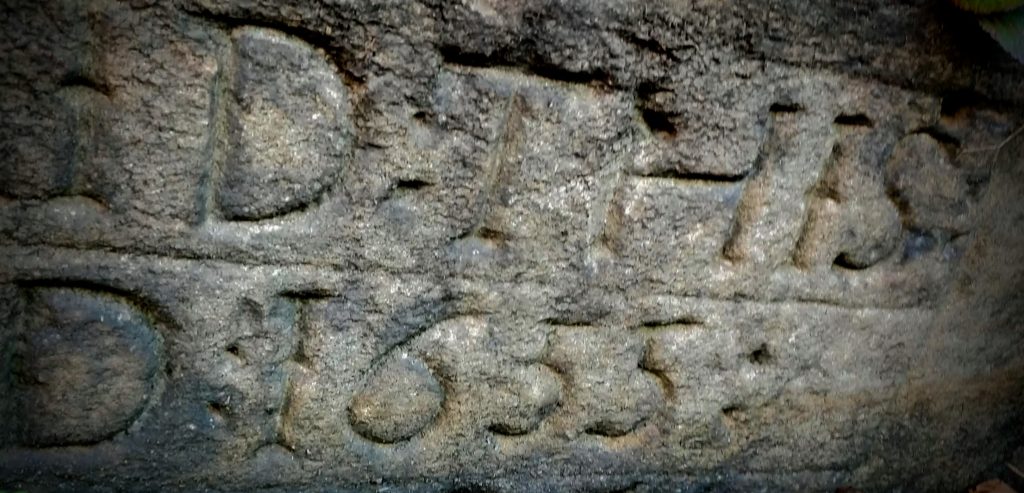
An Epithany
They knew what they faced and what had to be done and undone.
Unlike most people who face the night terrors and rise again, they did not ignore them and go to Wetherspoons for a stiff breakfast.
The stone. It was the stone.
They ordered the horses to be harnessed, they ordered the stone to be removed.
The horses legs nimbly found their feet in the wet sod, the load they held, seemingly nothing. In the end only one horse was needed. It cantered merrily up the steep hill bearing the suddenly light written stone back to the original place where it still stands today.
Come and look at it. It would make a real feature point in your conservatory.
I went there and was delighted by the positioning of the stone. I thought it would be surrounded by concrete homes, Barratts estates but instead plunged up a small straight lane, almost imagining the stomp of Roman legions behind me, old trees leaning sidewards against the wind. The holly is still there, the holly trying to take over the stone, the stone so flat and wide, the legend still etched so visibly in such a windswept place so amazingly still so far from anywhere. Who has tended to this stone for so long?
And as for the boggart, he who flits in and out of this sorry supernatural tale? Who knows- did he ever exist? Did he seek his escape when the stone was moved back to its original position?
Is he still there somewhere, an entity to blame when you step on Lego, your tights are ripped and your plates cracked beyond repair?
Does he still lie under this stone and what might happen if you moved it?
Has anyone got any horses?
I love the mystery of the stone and particularly, the questions asked at the end: “Does he still lie under the stone and what might happen if you moved it?” And more importantly, “Has anyone got any horses?” I am perfectly content to let things lie as they are and let them rest in peace!
Thanks for your reply- makes me so happy to know my blog is still being read- and gives me incentive to write some more! If you have read any MR James novels, it is ALWAYS best to not awaken anything unknown!
Thoroughly enjoyed your article and pass by this stone twice a day to and from work. I am also a firm believer in boggarts having been brought up in a not too distant village which had its own one.
I think more people should believe in boggarts. They are a good thing to blame instead of ones own incompetence when things go wrong
Awoken at 4am and compelled to open my Facebook and found this story! Defended from the Cottam fami!y. Weird. 😎
Thats a great fact- seems a popular name round these parts